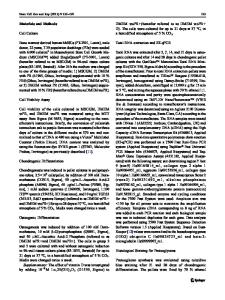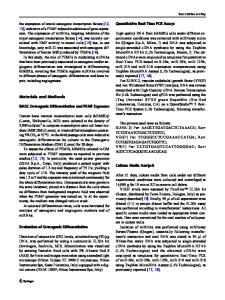Irradiation with blue light-emitting diode enhances osteogenic differentiation of stem cells from the apical papilla
- PDF / 1,323,194 Bytes
- 8 Pages / 595.276 x 790.866 pts Page_size
- 39 Downloads / 284 Views
ORIGINAL ARTICLE
Irradiation with blue light-emitting diode enhances osteogenic differentiation of stem cells from the apical papilla Yaoyao Yang 1,2 & Tingting Zhu 3 & Yan Wu 4 & Chunxia Shu 1 & Qiang Chen 1 & Juan Yang 1 & Xiang Luo 1 & Yao Wang 5 Received: 15 October 2019 / Accepted: 4 March 2020 # Springer-Verlag London Ltd., part of Springer Nature 2020
Abstract This study aimed to evaluate the effects of low-energy blue LED irradiation on the osteogenic differentiation of stem cells from the apical papilla (SCAPs). SCAPs were derived from human tooth root tips and were irradiated with 0 (control group), 1 J/cm2, 2 J/cm2, 3 J/cm2, or 4 J/cm2 blue light in osteogenic induction medium. Cell proliferation was analyzed using the 3-[4,5dimethylthiazol-2-yl]-2,5 diphenyl tetrazolium bromide (MTT) assay. Osteogenic differentiation activity was evaluated by monitoring alkaline phosphatase (ALP), alizarin red staining, and real-time polymerase chain reaction (RT-PCR). The results of the MTT assay indicated that SCAPs in the LED groups exhibited a lower proliferation rate than those in the control group, and there were statistically differences between the 2 J/cm2, 3 J/cm2, and 4 J/cm2 groups and the control group (P < 0.05). The results of the ALP and alizarin red analyses showed that blue LED promoted osteogenic differentiation of the SCAPs. And 4 J/cm2 blue light upregulates the expression levels of the osteogenic/dentinogenic genes ALP, dentin sialophosphoprotein (DSPP), dentin matrix protein-1 (DMP-1), and osteocalcin (OCN) in SCAPs. Our results confirmed that low-energy blue LED at 1 J/cm2, 2 J/ cm2, 3 J/cm2, and 4 J/cm2 could inhibit the proliferation of SCAPs and promotes osteogenic differentiation of SCAPs. Further in vitro studies are required to explore the mechanisms of the effects by low-energy blue LED. Keywords Mesenchymal stem cells . Stem cells from apical papilla . LED . Proliferation . Osteogenic differentiation
Introduction Dental stem cells include periodontal ligament stem cells (PDLSCs), dental pulp stem cells (DPSCs), stem cells from human exfoliated deciduous teeth (SHEDs), dental follicle progenitor cells (DFPCs), and stem cells from the apical papilla (SCAPs) [1]. Since Sonoyama W et al. successfully isolated SCAPs from the papilla of the root tip of young adult
Yaoyao Yang and Tingting Zhu contributed equally to this work. * Yao Wang [email protected] 1
Southwest Medical University, Luzhou 646000, China
2
Hospital/School of Stomatology, Zunyi Medical University, Zunyi 563000, China
3
Yantai Stomatological Hospital, Yantai 264000, China
4
West China-Guang’an Hospital, Sichuan University, Guang’an 638550, China
5
Hospital of Stomatology Southwest Medical University, Luzhou 646000, China
teeth, a large number of studies have proved that SCAPs have the abilities for self-renewal, high proliferation, and multidirectional differentiation to dentin, osteoblasts, and vascular nerve cells [2, 3]. SCAPs are usually derived from extracted orthodontic apical papilla tissues, forming root den
Data Loading...











